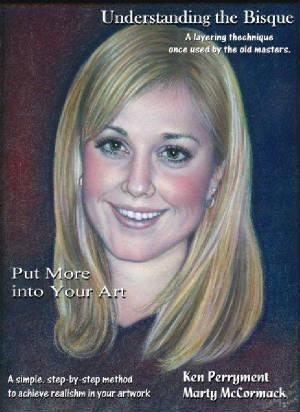 |

A new (but an old) way of approaching the mysteries of applying primaries as a base (bisque)
in layering and developing light from within and natural colouring, which breathes mood and life into your artwork.
The New Guidebook and CD are available
NOW
"Understanding the Bisque - Put More Life into Your
Art."
English Dictionary Definition
bisque :
(bisk) n. having the colour bisque (1655-1665)
The bisque is all about layers. Layer by layer, your drawing will come to life. Follow the sequence of applying
colour -- first blue, then red, then yellow, then all other colours -- and you can't go wrong.
Creating the bisque is
as easy as 1-2-3: (1) draw your subject first with warm and cool blues; then (2) add warm and cool reds; then (3) add warm
and cool yellows.
Learning to use the bisque will cost you very
little. All you need is: a supply of paper that takes colour well; six primaries (three warm, three cool); several other colours
(tints), typically used to bring out the lightest and the darkest areas.
The technique for
adding tints in dry-pastel is literally at your fingertips. When you blend in the soft tints into the bisque with the side
of your little finger, you mix the colours in a way that closely matches real life.
| Click on portrait to enlarge |
|
|
The bisque is your gateway to life like art.
Why? Because sunlight consists of the primary colours: blue red, yellow. When sunlight strikes anything, it creates shadows
-- and the bisque is shadow. Some shadows are deep, sharp, nearly black; others are soft and gentle, appearing often as pale
grays or blues.
This means you can create the bisque in many different densities. When you create bisque of the appropriate density,
you're duplicating real-life shadows that define your subject. What's more, you create an underlay, over which all the tint
colours appear more natural.
You don't
have to be a Master to master the bisque. With several practice drawings under your belt, you'll begin to notice that you're
developing consistency. This is because you're following the same process, time after time. And then, with a few more drawings
in which to increase the degree of detail, you'll notice that you're drawings are becoming truer to life.
This Pastel Portrait is
a BISQUE example done from the photo on the right
| Click of photo to enlarge |
|
|
When you begin to produce life-like artwork consistently,
you open the door for passion to come in. You begin to create a strong mood in your subject. And this mood leads to your developing
a personal style; that is, you begin to find out what techniques work best for you. For example, these techniques may lie
in a certain theme colour, or consistent use of strong or soft borders, or a way of grading from dark to light, or a distinctive
use of perspective.
In summary, experience with the bisque plants seeds for your growth as an artist. First, you learn
to think in terms of light and shadow. Second, you learn to delineate your subjects by creating realistic shadow -- with practice,
you create lifelike art, no matter what the subject. Third, you learn to emphasize the mood or the "feel" of the artwork.
And, finally, after experimenting with various techniques, you begin to develop a personal style. This will become your signature
as an artist.
|



